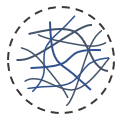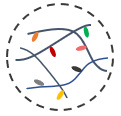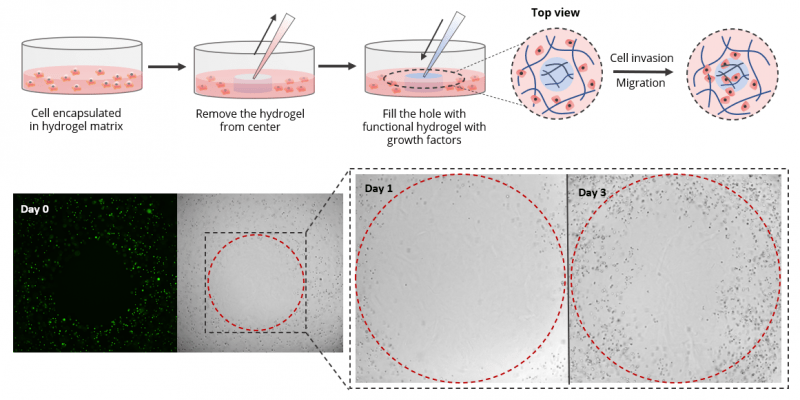Cell Invasion Assay
Cell invasion assays are an important tool to study cell mobility. The hydrogel matrix not only provides the structural scaffold but also induces cell-matrix interaction for cell mobility. The traditional animal-based ECM contains complicated components that not only introduce unpredictability to 3D cell invasion study but also cause the lack of understanding of the effect of ECM on cell mobility.
Our state-of-the-art VitroGel hydrogel system can closely mimic the physiological and functional properties of the native ECM and give an outstanding balance of biological complexity and operating ease for an in-depth understanding of the relationship between the microenvironment and cell mobility. The tunable and functional hydrogel system can be manipulated to study many different factors, such as mechanical strength, degradation, functional ligands, and serum/growth factors/cytokine/chemokine that affect cell mobility.
The cell invasion with VitroGel® can be performed with an insert or a well plate for:
- Vertical movement
- 3D hydrogel migration/invasion for horizontal movement
- 3D Cell Spheroid Invasion Assay
Multiple ways to use VitroGel for cell invasion assay

Use an Insert or a Well Plate for Vertical Invasion
Using a plate insert or well plate is a typical way to observe cell invasion. Besides the differences in medium components inside or outside of the insert, the tunable and functional VitroGel system can be manipulated to study many different factors such as mechanical strength, binding ligands on cell mobility.

3D Hydrogel Migration/Invasion (Horizontal Movement)
The 3D horizontal invasion can be studied by encapsulating cells in a hydrogel matrix. Scientists can adjust the properties of the hydrogel in the same well and observe the cell movement within the hydrogel matrix.


3D Spheroid Invasion Assay
Spheroid culture allows better preservation of the interactions between cells and/or between cells and the extracellular matrix. The spheroid invasion can be established by adding the cell spheroid directly on top of a layer of hydrogel or encapsulating inside of the hydrogel matrix for 3D cell mobility study.

How to select VitroGel for Cell Invasion Assay
The simplest answer to this question is to choose the ready-to-use VitroGel Hydrogel Matrix (Cat# VHM01). This multifunctional hydrogel system has been designed to support a wide range of cell types and cell mobility. Besides VitroGel Hydrogel Matrix, researchers can also choose the VitroGel ORGANOID Discovery Kit (Cat# VHM04-K), which contains four different versions of ready-to-use VitroGel to support cells from different resource and co-culture systems.
For researchers who want to have an in-depth understanding of the relationship between the microenvironment and cell behaviors, the high concentration VitroGel hydrogels provide an excellent system that can be easily manipulated in hydrogel strength, binding ligand, degradability, and supplement compositions (see the effect of each factor below).
Please check here for the full list of high concentration VitroGel hydrogels >

Mechanical Strength
The cell mobility under different hydrogel mechanical strengths can be studied by adjusting the hydrogel concentrations with VitroGel Dilution Solution. The typical gel strength range from 10 to 4,000 pa and the customized higher concentration hydrogel can get over 20,000 Pa.

Degradation
Using the VitroGel MMP, the matrix metalloproteinases sensitive hydrogel, the effect of biodegradation on cell mobility can be studied. VitroGel MMP can also mix with other functional VitroGel systems for a more complex microenvironment.

Functional Ligands
Multiple biological functional ligands are incorporated for different versions of VitroGel, which promote cell attachment, cell-matrix interactions, and cell mobility. Taking the advantage of “Mix and Match” capability of VitroGel, scientists can also build a multi-functional VitroGel with different ratios of different functional ligands.

Serum/Growth Factors/Cytokine/Chemokines
The different concentrations of serum, growth factors, and chemokines can be directly mixed with VitroGel or added to the outside of the insert well to induce the cell movement.
Case Studies
Effects of FBS Concentration

Invasion of B35 neuroblastoma cells on VitroGel system. VitroGel RGD was used as 2D hydrogel coating on the surface as a cell insert. B35 cells were added directly on top of the hydrogel. The hydrogel was prepared at 1:3 dilution with 2% FBS. The cells were harvested from 2D culture plate with 10% FBS and resuspended in FBS free medium before adding to the top of the hydrogel. The medium outside of the insert well contained 20% FBS. The cell invasion was induced by the different concentrations of FBS in the cover medium, hydrogel, and the medium outside of the insert. The images were taken on day 7.
Effects of Binding Ligands for Cell-Matrix Interactions

Invasion of U-87 MG glioblastoma cells on different functional VitroGel systems. VitroGel 3D was used as negative control and the RGD modified hydrogel (VitroGel RGD) was used to induce cell invasion. The hydrogel was prepared at 1:5 dilutions without FBS. The cells was harvested from 2D culture plate with 10% FBS and resuspended in a culture medium with 1% FBS before adding to the top of the hydrogel. The medium outside of the insert well contained 1% FBS and 2% human platelet lysate. The images were taken at the bottom of the insert well after 48 hrs.
3D Hydrogel Migration/Invasion

3D Invasion of U-87 MG Glioblastoma Cells in VitroGel system. U-87 MG cells were encapsulated in VitroGel RGD with 2% FBS and seed to a cell culture plate. After gel stable (30-60 min), use a micropipette to create a 5-10 µl hole by sucking the cell/hydrogel mixture out. Fill the hole with VitroGel RGD with 20% of FBS without cells. Add the cover medium with 10% of FBS on top of the hydrogel. The different concentrations of FBS in the hydrogel matrix would induce the cell invasion/migration within the hydrogel matrix. The cells movement was observed under a microscope with Z-stack function. The projecting images were created with different z levels.
3D Spheroid Invasion Assay

3D spheroid invasion assay of U-87 MG cells in VitroGel 3D and VitroGel Hydrogel Matrix. Growth of cell spheroids over time in the VitroGel 3D (a and b) and the VitroGel Hydrogel Matrix (c and d). The spheroid in VitroGel 3D maintained the spheroid morphology with an expansion in size from day 1 to day 7 without developing epithelial extensions characteristics. However, spheroids grown in VitroGel Hydrogel Matrix produced not only significantly larger spheroids by day 7 but invading epithelial structures, demonstrating the clear cell penetration into the hydrogel matrix.
Research Publications using vitrogel for invasion applications
- Shamloo, B., Kumar, N., Owen, R. H., Reemmer, J., Ost, J., Perkins, R. S., & Shen, H.-Y. (2019). Dysregulation of adenosine kinase isoforms in breast cancer. Oncotarget, 10(68). https://doi.org/10.18632/oncotarget.27364
- Mahauad-Fernandez, W. D., & Okeoma, C. M. (2018). B49, a BST-2-based peptide, inhibits adhesion and growth of breast cancer cells. Scientific Reports, 8(1). https://doi.org/10.1038/s41598-018-22364-z
- Di Donato, M., Cernera, G., Migliaccio, A., & Castoria, G. (2019). Nerve Growth Factor Induces Proliferation and Aggressiveness in Prostate Cancer Cells. Cancers, 11(6), 784. https://doi.org/10.3390/cancers11060784
- Shen, S., Dean, D. C., Yu, Z., Hornicek, F., Kan, Q., & Duan, Z. (2020). Aberrant CDK9 expression within chordoma tissues and the therapeutic potential of a selective CDK9 inhibitor LDC000067. Journal of Cancer, 11(1), 132–141. https://doi.org/10.7150/jca.35426
- Ramos, R. I., Bustos, M. A., Wu, J., Jones, P., Chang, S. C., Kiyohara, E., Tran, K., Zhang, X., Stern, S. L., Izraely, S., Sagi‐Assif, O., Witz, I. P., Davies, M. A., Mills, G. B., Kelly, D. F., Irie, R. F., & Hoon, D. S. B. (2020). Upregulation of cell surface GD3 ganglioside phenotype is associated with human melanoma brain metastasis. Molecular Oncology. https://doi.org/10.1002/1878-0261.12702
- Ogino, T., Matsunaga, N., Tanaka, T., Tanihara, T., Terajima, H., Yoshitane, H., Fukada, Y., Tsuruta, A., Koyanagi, S., & Ohdo, S. (2021). Post-transcriptional repression of circadian component CLOCK regulates cancer-stemness in murine breast cancer cells. ELife, 10, e66155. https://doi.org/10.7554/eLife.66155


